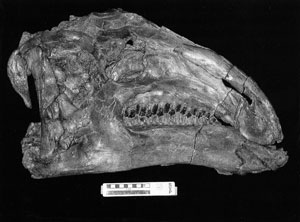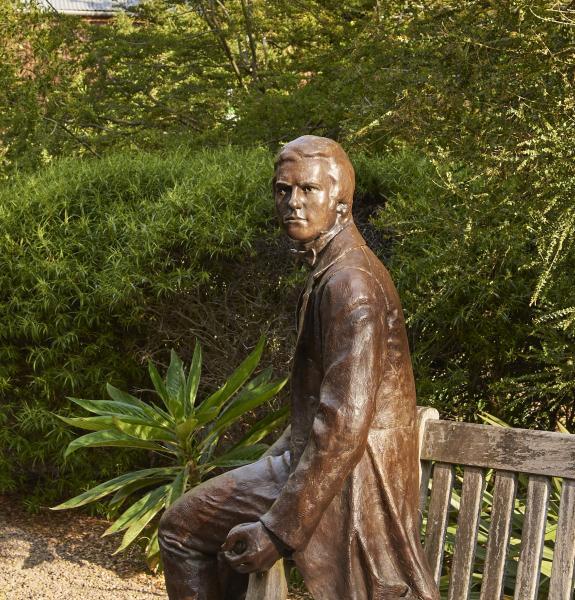A Strange Honour!

This (pictured right) is the well-preserved skull of a new dinosaur (Equijubus normani) collected from Inner Mongolia and named in honour of David by a group of palaeontologists from China and America. This dinosaur is similar to others such as Iguanodon and several other related taxa (known in Britain and the European mainland). David has published a range of monographs on the anatomy, taxonomy and systematics of dinosaurs such as Iguanodon (the skeleton of an Iguanodon can be seen at the Sedgwick Museum here in Cambridge). This is one of many discoveries that feed into our understanding of the evolutionary history of dinosaurs during the tectonically and geographically complex 'middle' Cretaceous (~100 million years ago).
The focus of such work is concerned with exploring the diversity of vertebrate (backboned) life on Earth during the Mesozoic Era by integrating anatomy, physiology, ecology and geology. This work is integral to palaeobiology, but is of interest to evolutionary biologists, systematists, biostratigraphers and tectonic modellers.
Fresh Discoveries
Painstaking reconstruction of species that are entirely new to science, or of ones that have been perhaps poorly described in the past, greatly improves the understanding of the range and diversity of vertebrate life. Recent work has focused on early ornithischian dinosaurs: Heterodontosaurus (from the Early Jurassic of S. Africa) and Scelidosaurus from the Early Jurassic of England. More recently new material of dinosaurs has been discovered in the Wealden aged rocks of Sussex; these are also new to science and are being exavated, prepared in the laboratory and then described; these discoveries include new taxa such as Barilium and Hypselospinus that David has named in recent years.
Current Research Themes
This includes: systematics and phylogenetic reconstruction (in order to investigate the processes of evolution among animals that lived in the past); the links between animal distributions, the movements of the continents over time and the relationship between continental fragmentation and evolutionary patterns (vicariance biogeography); functional investigations on the anatomy, morphology and evolution of archosaurian reptiles; 'palaeoengineering' (using finite element modelling) notably in relation to how skulls are constructed in order to cope with the stresses and strains associated with feeding; and palaeoecology in order to develop the first truly rigorous assessment of abundances and diversities of fossil animals.
New Research Directions
Work has been published on the systematics and evolution of basal (early) ornithischian dinosaurs; this sprang out of an expedition to South Africa undertaken by David in the 1990s, which led him to undertake a detailed study of the Early Jurassic South African dinosaur known as Heterodontosaurus. Additional research is also being undertaken in the light of a major piece of descriptive work that he is undertaking on an English armoured dinosaur known as Scelidosaurus, which comes from the Early Jurassic rocks exposed at Lyme Regis in Dorset. Also related to this work, a complete revision of stegosaurian dinosaurs (the curiously 'plated' dinosaurs related to Stegosaurus) has been published recently; this study was the first of this type in nearly a century. New dinosaur discoveries in Sussex are leading to fresh research on the evolution and relationships of Cretaceous ornithischian dinosaurs and their evolutionary relationship to the hadrosaurian (duck-billed) dinosaurs that are so abundant in Late Cretaceous rocks on North America.
In addition, entirely new work has been undertaken on the taxonomy, functional morphology and evolutionary history of pliosaurs (giant marine reptiles of the (Mesozoic). Finally a novel investigations have been undertaken into the systematics and biogeographic distributions of Late Cretaceous and Early Tertiary vertebrate groups to explore the link between their evolutionary histories and tectonically-driven continental movements.
Several of David's PhD students are now academics in their own right based at Oxford University, UCL, Imperial College, Bristol, Birmingham, Oxford University Museum of Natural History and at the Natural History Museum (London).
Other Things
Among 'other things' David is a rugby (union) referee (and also Hon. Pres. CCRFC!) spending his weekends (during the season) refereeing club matches around the county and beyond and, when he can spare the time, he even referees a few college midweek games. He also enjoys fell-walking (away from Cambridge obviously!) and relaxes by doing pen & wash sketching (if ever time allows).


